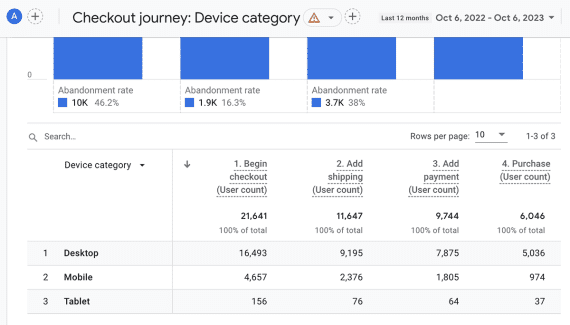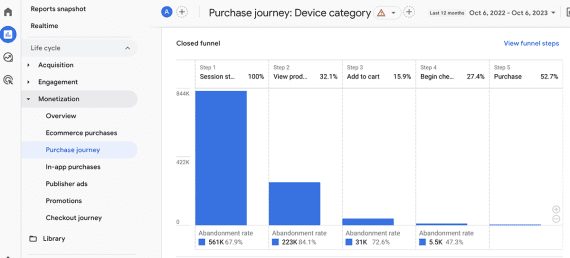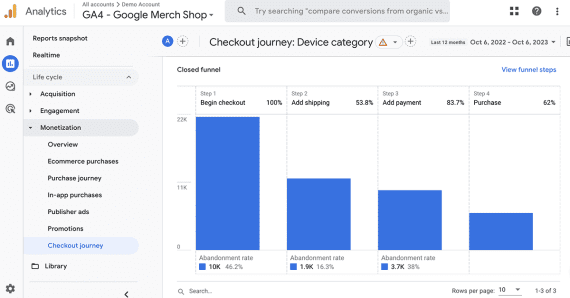New ecommerce-focused Google Analytics reports could help merchants identify issues with shopper journeys and the checkout process.
The Google Analytics 4 purchase journey report shows the funnel from when a would-be customer starts a web session through purchase. And the newer checkout journey report displays the checkout funnel in four detailed steps.
Both reports show where shoppers abandon the buying journey. The data could identify problems in a store’s navigation or point out opportunities for tests or optimization.
Checkout Journey Report
Found under Reports > Monetization in GA4, the checkout journey report shows the number and percentage of users who start the checkout process on an ecommerce site or app and then complete each subsequent step.
It uses a closed funnel method, focusing only on shoppers who started at the “Begin checkout” step.
The report can identify bottlenecks or issues in the checkout flow. For example, a business with a massive drop-off after the shipping step could have a technical or pricing problem with the available delivery options.
Checkout Steps
For the checkout journey report, data is collected from four GA4 events.
- begin_checkout for the “Begin checkout” step.
- add_shipping_info for the “Add shipping” step.
- add_payment_info for the “Add payment” step.
- purchase for the “Purchase” step.
Merchants will add these events to the checkout flow. Google offers implementation instructions for desktop and mobile devices to ensure the proper GA4 event is specified at each checkout stage.
gtag("event", "begin_checkout", {...
Checkout Dimensions
When its report loads, the checkout journey will show the flow by “device category,” i.e., mobile or desktop. But the report may also include other dimensions. Here is the complete list:
- Device category,
- Country,
- Region,
- City,
- Language,
- Age,
- Gender,
- Browser.
Thus marketers can find checkout glitches for a specific group of shoppers.

The table in the checkout journey report is initially divided by device category, but other dimensions are available. Click image to enlarge.
Purchase Journey Report
The GA4 purchase journey report provides insights into shopper drop-offs at each step of the funnel, although with less detail during the checkout. The two reports can work together to identify optimization opportunities.
The purchase journey report is located in GA4 at Reports > Monetization.

The purchase journey report shows buyers’ actions from session start to purchase, although the report for checkout journeys is more detailed. Click image to enlarge.
Purchase Steps
The purchase journey report gathers data from five GA4 events:
- session_start marks the start of a session.
- view_item is triggered when a product is viewed.
- add_to_cart is triggered when an item is added to the cart.
- begin_checkout for the “Begin checkout” step.
- purchase or in_app_purchase for the “Purchase” step.
Like the checkout journey report, the GA4 events for collecting purchase journey data will need to be set up and added to the appropriate pages of an ecommerce website.
Some ecommerce platforms include some or most of these events in their GA4 integration. For example, Shopify’s GA4 integration automatically adds the view_item, add_to_cart, purchase, and several other events.
Purchase Dimensions
As of October 2023, the purchase journey report had the following analytics dimensions, two fewer (age and gender) than the checkout journey report:
- Device category,
- Country,
- Region,
- City,
- Language,
- Browser.
Using the Reports
The reports and funnels described here are helpful only if ecommerce marketers use them to optimize the buyer’s journey. Here’s an example.
Monitor the funnel. Start by watching the funnel, paying attention to how promotions, days of the week, or holidays impact buyers’ journeys.
Find drop-offs. Any point in the purchase or checkout funnel where shoppers drop off is a potential problem or opportunity.
Investigate. Examine drop-off points and hypothesize on the underlying cause. For example, loads of shoppers leaving at the shipping step could indicate the cost is too expensive relative to the average order value.
Take action. Address the potential cause of a drop-off and implement a solution. This could be a test at the add_shipping_info step that reduces the shipping cost.
Watch and iterate. Did the test work? Are more shoppers arriving at the next step? Measure the results. If the drop-off continues, develop a new hypothesis and solution.
Keep optimizing. Include optimizing the buyer’s journey as a routine marketing activity.
Can’t Find the Reports?
Add purchase journeys and checkout journeys from the report library if they do not appear under Reports > Monetization.





